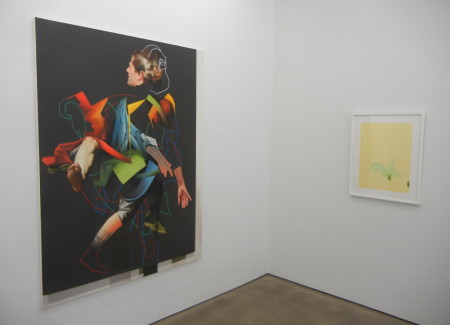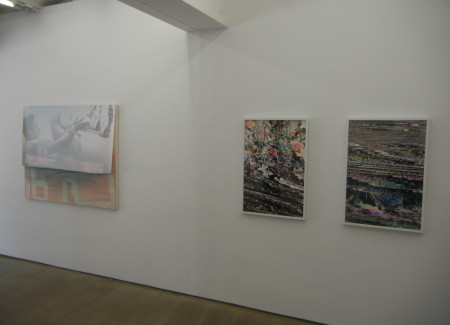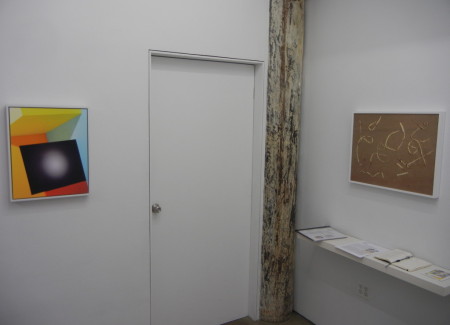Frameshift @Denny Gallery
By Loring Knoblauch/ In Galleries/ June 27, 2014
JTF (just the facts): A group show containing a total of 11 works by 6 different artists/photographers, generally framed in white and unmatted, and hung against white walls in the two room gallery space. The show was curated by useful pictures (here).
The following artists/photographers have been included in the show, with the number of works on view and image details as background:
- Lorne Blythe: 2 archival inkjet prints mounted on sintra, 2013, sized 24×18, in editions of 8
- Heather Cleary: 2 archival inkjet prints on cotton rag paper mounted on sintra with luster laminate, 2013, sized 36×45 or 19×24, in editions of 3+2AP
- Erin O’Keefe: 3 archival inkjet prints mounted on sintra, 2013 and 2014, sized 36×24 or 20×16, in editions 0f 3+2AP
- Pieter Schoolwerth: 1 oil, giclee print, and oil pastel on canvas, 2013, sized 77×58, unique
- Barry Stone: 2 archival inkjet prints mounted on sintra, 2013, sized 36×24, in editions of 3
- Wendy White: 1 acrylic on canvas, inkjet print on vinyl, 2014, 48×60, unique
(Installation shots below.)
Comments/Context: One of the prevailing (and surprisingly durable) trends out on the leading edge of contemporary photography is the ongoing exploration of photographic uncertainty, the place we end up when proof and evidence break down. Whether it’s conscious optical distortion and trickery, chance and improvisation in process, or a more conceptual unpacking of the medium, photographers continue to aggressively push on the traditional definitional boundaries, working their way into the undefined and open ended intermediate zones where things often aren’t what they seem. This show brings together a handful of artists probing this genre of purposeful doubt and allows their varied approaches to catalyzing visual instability intermingle and connect.
Pieter Schoolwerth and Wendy White might both be better understood as painters, but their use of photographic imagery in unexpected ways pulls them back into a more interdisciplinary zone. Schoolwerth’s tangled figure incorporates oil stick outlines, painted areas, and blurred pixelated inkjet printing, with thick hand drawn brushstrokes overlapping with digital gestures in an ever shifting, cacophonous swirl of hands, feet, and moving body parts; his hybrid seamlessly merges photography in with layers of painting, employing image fragments with the same ease as his other materials. White’s experimentation with photographic processes feels more jarring. Her appropriated injured soccer player floats on a sheet of vinyl, draped down like a curtain over a canvas inscribed with stylized lettering and graphic shapes; a bold arm’s length brushstroke sweeps across both parts, forcing the two into dialogue, mixing the separate physical spaces and pushing the whole back toward Rauschenberg-like combination.
Erin O’Keefe and Heather Cleary are in many ways the traditionalists in this group, exploring the nature of photographic seeing and camera-driven distortion. O’Keefe’s works play with planes, the simplest exploring the relationships of flat geometric surfaces and the shadows they cast. A larger, more complicated construction with mirrors, tape, black dowels, and various other materials moves toward the work of Barbara Kasten, where perspectives are twisted to the point of satisfying confusion. Cleary’s images are more illusionistic, using trompe l’oeileffects that test our ability to understand what we are being shown. Variegated leaves covered with dapples of white paint blend into the painted backdrop, creating a surface that shuffles from 2D to 3D and back again. And thin strips of what appear to be artfully curved wood shavings (or Siskind-like seaweed) turn out to be decaying banana strings.
The works by Barry Stone and Lorne Blythe dive deeper into the technology of digital picture making and the new processes that can be exploited there. Via a series of coding and manipulation steps, Stone purposefully corrupts his image files, creating photographs that are cut into hundreds of color tweaked horizontal strips; the effect is something like digital static, where the image comes in and out of recognizability as the exuberant engineered glitches filter through the picture. Blythe’s works hover in an impossible world of commercial perfection, where shadowless lighting makes it impossible to tell what is real and what is stock, appropriated, or otherwise inserted. Plastic measuring triangles and colored dice stand against featureless backgrounds, teasing us with apparent depth and clarity but then ultimately leaving us unsure and uneasy about their reality.
Seen together, this show is a smartly edited report from the front lines, highlighting a number of artists that will likely be unfamiliar to many. Each one is pushing photography to a dissonance point, and then lingering in that inharmonious spot where definitions are more fluid and new investigations can take place. While the view is disconcertingly inward looking (the old photography about photography issue once again), the approach is clearly providing a consistent trail of bread crumbs for those searching for new artistic white space to call their own.
Collector’s POV: The works in this show are priced as follows, by artist/photographer:
- Lorne Blythe: $1750 each
- Heather Cleary: $2400 and $4400
- Erin O’Keefe: $1740 and $2925
- Pieter Schoolwerth: $38000
- Barry Stone: $2800 each
- Wendy White: $10500
None of these artists/photographers has a significant track record in the secondary markets for photography, so gallery retail likely remains the best option for those collectors interested in following up.





